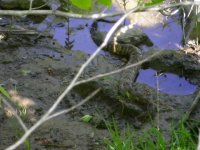salmonoid
Well-known member
- Joined
- Jun 19, 2007
- Messages
- 2,721
Rattler encounters:
Three at my parents' cabin. It is on the side of Bald Eagle Mountain. Talus slope all around, with flat sites scratched out of the talus for the cabins. None were in the sun.
Two in Sullivan County, at about 1500 feet elevation. One was under a rock and the other slithered up the side of a ledge (rock and also covered with leaves and dirt) and barreled away through the tall grass.
Three in Potter County - one right beside a stream, under a rock, a second right above a stream, on a bank covered in ferns about two feet off the water, the third both below and then coiled above a trail, under a fern, as he crossed uphill as I stepped over him.
A few I've seen in Lycoming County were up on top of a plateau.
I have seen one or two dead on highways, but overall, my experience has either been encountering them streamside, on the tops of plateaus, or spread out over a talus slope.
Diamondbacks I have encountered have almost always been tucked underneath sage brush or other desert type bushes.
Three at my parents' cabin. It is on the side of Bald Eagle Mountain. Talus slope all around, with flat sites scratched out of the talus for the cabins. None were in the sun.
Two in Sullivan County, at about 1500 feet elevation. One was under a rock and the other slithered up the side of a ledge (rock and also covered with leaves and dirt) and barreled away through the tall grass.
Three in Potter County - one right beside a stream, under a rock, a second right above a stream, on a bank covered in ferns about two feet off the water, the third both below and then coiled above a trail, under a fern, as he crossed uphill as I stepped over him.
A few I've seen in Lycoming County were up on top of a plateau.
I have seen one or two dead on highways, but overall, my experience has either been encountering them streamside, on the tops of plateaus, or spread out over a talus slope.
Diamondbacks I have encountered have almost always been tucked underneath sage brush or other desert type bushes.





